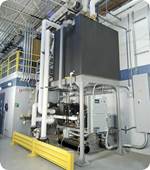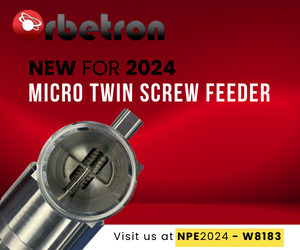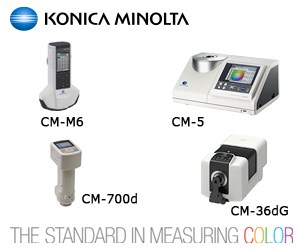Central or Portable? Flexibility Favors ‘Discrete’ Chillers
Why might discrete chillers be a solution in your plant? In a word: Flexibility. Here is the lowdown.
When we consider the alternative to central chilling systems, we often think of so-called “portable” chillers—relatively small units mounted on casters that can roll from application to application within your facility. But these chillers are not always portable. Perhaps a better term for them is “discrete” chillers.
A discrete chiller can have an outdoor remote condenser (not very portable) or an elaborate ductwork system to exhaust warm air in the summer and provide supplemental heat in the winter (also not very portable). A discrete chiller can provide 30, 40, or 50 tons of cooling capacity, making the units quite large. Yet they are dedicated to a specific application or use point (not so portable). For our purposes here, we will consider a discrete chiller as one that is used to cool a single process or processing machine. Some may refer to this as a manufacturing cell.
Why might discrete chillers be a solution in your plant? In a word: Flexibility. Here are some illustrations:
•More control at a lower cost: Discrete chillers offer the advantage of unique fluid setpoints for each use point. This can eliminate the need for having both a central system and separate mold-temperature control units that are often required to tweak the bulk fluid temperature provided by the central system. This can save capital cost and operating costs for such a hybrid system. This option also allows the processor to select the best temperature for each process, without compromise. If you change to a new mold, you simply change the temperature to accommodate that mold’s needs.
•Repeatable temperature and flow performance: Since a discrete chiller is close-coupled to the process, the fluid flow and temperature are consistent and not dependent on other machines operating in the plant, providing more consistent production rates and process quality.
•Minimized risk and exposure in the event of a problem: If you have a problem with a discrete chiller, it impacts the production of only one machine. Compare this to a central-chilling system: Even with multiple refrigeration circuits, a circuit problem can take multiple machines out of production.
•Quicker delivery and easy installation: Discrete chillers take less time for your supplier to produce and can be installed relatively quickly and inexpensively. Many discrete chillers are available from stock or with short lead times and require only power and hoses to get into production, whereas central systems require vast, expensive piping networks and long lead times.
•Customized, low-cost configurations: The options include self-contained, air-cooled, water-cooled, or units with outdoor condensers. Maybe you need a bigger pump or a specific feature for your process? Customizing a single unit for your application is usually easy and cost-effective with a discrete chiller.
•Easy-to-access information: A discrete chiller’s control system provides processors with information on parameters such as to-process fluid temperature and pressure—at the use point. As a result, fluctuations in either can be addressed more quickly. Some discrete chillers can provide additional data, including flow rate and from-process temperature, allowing the molder to truly understand what is going on in the process to optimize cycle time and part quality. A central chiller system often lacks this information at the use points or requires an additional investment in components and installation costs.
•Ability to adapt to changing cooling loads: Technology has advanced to allow today’s discrete chillers to adapt quickly and with energy efficiency as cooling-capacity needs change. Digital scroll compressors available from some manufactures can operate with energy savings at 20% to 100% cooling loads, unlike older portable chillers that had a smaller operating band and no energy savings.
•Easy to expand when you do: If your central cooling system, including the piping-distribution network, hasn’t been thoroughly thought out at the time of installation to allow for system expansion, growing a system can be expensive and difficult. With discrete chillers, you simply add a processing machine and a chiller and you’re ready to go.
•Lower operating costs: Using discrete chillers eliminates the cost to transport cooling fluid through long and often undersized distribution piping networks.
•Fewer maintenance hassles: While it’s true that having a number of discrete chillers escalates the parts count relative to a central system—many more compressors, pumps, solenoid valves, electrical controls, etc.—consider that these components are generally much smaller on discrete chillers. For example, a 100-ton chiller may have two 50-hp compressors, whereas 10 discrete chillers of 10 tons each provide the same capacity with 10-hp compressors. When a problem occurs, a 10-hp compressor is far less costly to repair or replace than a 50-hp compressor. The complexity of a central chiller system, with high-level PLC-based controls and specialized compressor technology, often requires highly skilled and hard-to-find refrigeration technicians.
•First-time cost: This is always an important consideration for processors. A few discrete chillers with total cooling capacity of around 60 tons or less can often have initial cost for equipment and installation that are far lower than a small central system. But for larger system capacities, the cost of multiple discrete chillers is often higher than a comparable central system.
In the end, when considering discrete vs. central chilling, you must do what is best for your facility, production requirements and budget by evaluating and ranking the importance of the factors described above and perhaps others that are unique to your situation. Remember to use your industry resources whenever you can.
Related Content
Solve Four Common Problems in PET Stretch-Blow Molding
Here’s a quick guide to fixing four nettlesome problems in processing PET bottles.
Read MoreHow Was K 2022 for Blow Molding?
Over a dozen companies emphasized sustainability with use of foam and recycle, lightweighting and energy savings, along with new capabilities in controls, automation and quick changeovers.
Read MoreAt NPE, Cypet to Show Latest Achievements in Large PET Containers
Maker of one-stage ISBM machines will show off new sizes and styles of handled and stackable PET containers, including novel interlocking products.
Read More50 Years...600 Issues...and Still Counting
Matt Naitove marks his first half-century in plastics reporting, with a few of his favorite headlines.
Read MoreRead Next
Central or Portable? ‘Off-the-Floor’ Central Chillers Cost Less, Provide Processing Gains
In deciding whether to use portable or central chillers, there are a variety of variables to consider. Here are the key issues.
Read MorePeople 4.0 – How to Get Buy-In from Your Staff for Industry 4.0 Systems
Implementing a production monitoring system as the foundation of a ‘smart factory’ is about integrating people with new technology as much as it is about integrating machines and computers. Here are tips from a company that has gone through the process.
Read MoreFor PLASTICS' CEO Seaholm, NPE to Shine Light on Sustainability Successes
With advocacy, communication and sustainability as three main pillars, Seaholm leads a trade association to NPE that ‘is more active today than we have ever been.’
Read More

























